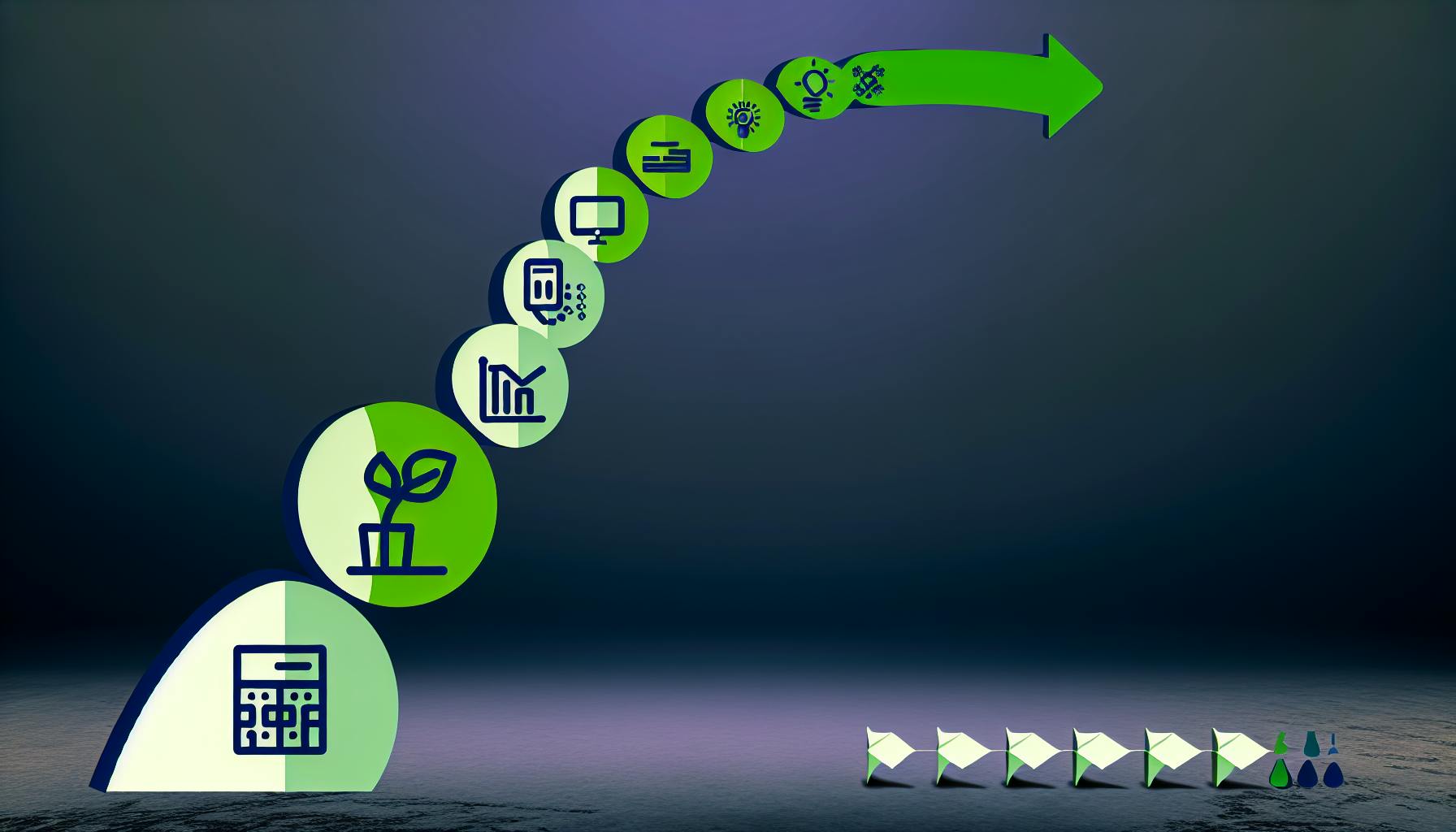Most SMEs want to reduce their climate emissions, but struggle with where to start.
This strategic guide provides a clear blueprint for SMEs to effectively cut emissions, while transforming sustainability into a competitive edge.
You'll learn key concepts like conducting an emissions audit, setting a baseline carbon footprint, and identifying high-impact reduction strategies across operations. Discover how to engage employees, suppliers, and stakeholders in emissions cuts, access green financing, certify sustainable practices, and attract values-driven talent to build market advantage.
Introduction to SME Climate Strategies
Reducing climate emissions is an increasingly crucial task for businesses of all sizes. Small and medium-sized enterprises (SMEs) have a major role to play in mitigating climate change, but may find the process daunting. This introduction sets the context for SMEs looking to integrate sustainability into their business models.
The stakes around climate action continue rising. Scientific consensus shows greenhouse gas emissions must halve by 2030 to restrict global warming within 1.5°C this century. Failure risks environmental instability and displacement impacting communities, alongside tightened regulations and market penalties for carbon-intensive companies.
Simultaneously, sustainability provides new opportunities. Consumers and investors increasingly favor eco-conscious brands with net-zero commitments. Streamlining operations slashes waste and energy expenses. Carbon accounting illuminates savings potential within logistics, facilities and supply chains.
For SMEs targeting growth while minimizing climate impact, building sustainability into the core business strategy is prudent. EcoHedge's sustainability software provides the tools for measurable emissions tracking, transparent climate reporting and effective stakeholder engagement guiding this transition. With the right climate strategy and supporting solutions, SMEs can transform sustainability from a challenge into an engine of innovation and competitive edge.
What is the meaning of climate emissions?
Emissions refer to the release of greenhouse gases like carbon dioxide (CO2), methane (CH4), and nitrous oxide (N2O) into the atmosphere. These emissions come from human activities across different sectors like energy, transportation, buildings, agriculture, and more. When we talk about "climate emissions", we specifically mean emissions that cause climate change by trapping heat in the atmosphere.
The main greenhouse gas emitted is CO2 from the burning of fossil fuels. Other major sources are methane from agriculture and landfills, nitrous oxide from agricultural activities, and fluorinated gases from industrial processes. Tracking emissions allows us to understand their source and take steps to reduce them. With climate change accelerating, curbing emissions is crucial for SMEs to limit their impact and exposure to climate risk.
What are emissions climate change?
Climate change is driven by greenhouse gas emissions generated from human activities like burning fossil fuels, deforestation, and industrial processes. These emissions act like a blanket around the Earth, trapping heat from the sun and causing global temperatures to rise.
The main greenhouse gases contributing to climate change are:
- Carbon dioxide (CO2): Released largely by burning fossil fuels like coal, oil, and gas. CO2 makes up over 75% of global emissions.
- Methane (CH4): Generated by landfills, livestock, and the production/transport of coal, oil and gas. Methane has 80 times more warming power than CO2 over a 20-year period.
- Nitrous oxide (N2O): Emitted from agricultural practices like fertilizer application and livestock waste. N2O has about 300 times more warming potential than CO2.
Rising emissions have caused the Earth's surface temperature to increase by 1°C since pre-industrial times. But scientists warn that exceeding 1.5°C of warming will trigger catastrophic climate impacts.
To prevent this, deep cuts to greenhouse gas emissions are urgently needed across all sectors. Tracking emissions via solutions like EcoHedge software can help businesses monitor their footprint and take strategic climate action.
What are the top climate emissions?
According to the IPCC, the top sources of greenhouse gas emissions globally are from electricity and heat production, agriculture, forestry and other land use, industry, and transportation. Within these sectors, the largest contributors are:
- Combustion of coal, natural gas, and oil for electricity and heat: These fossil fuels emit CO2 when burned. In 2021, 38% of total global greenhouse gas emissions came from electricity and heat production from these sources.
- Livestock and manure management: Agriculture accounts for 13.5% of global emissions, with animal husbandry constituting nearly two-thirds of that figure. Cattle emit methane, with manure releasing both methane and nitrous oxide.
- Deforestation and changes in land use: Removing carbon-absorbing forests and vegetation for commercial or residential use releases stored CO2 back into the atmosphere. This accounts for around 11% of total emissions as of 2021.
- Fuel consumption from transportation: Burning gasoline and diesel to power cars, trucks, ships and planes released 7.9 billion metric tons of CO2 in 2021, over 20% of total emissions.
To meet climate targets, the top priority is transitioning electricity production from fossil fuels to renewables like solar and wind. Curbing deforestation and changes to land use is also critical, as is exploring lower-emission transportation options. Companies should conduct audits analyzing their operations, supply chain, and product lifecycles to identify and address emission hotspots specific to their business.
sbb-itb-919600f
How are climate emissions measured?
Greenhouse gas emissions are quantified in units of carbon dioxide equivalent (CO2e), which allows different greenhouse gases to be compared on a common basis. This is necessary because different greenhouse gases have varying global warming potentials.
For example, 1 tonne of methane has the same global warming impact as 28-36 tonnes of carbon dioxide over 100 years. By converting emissions to carbon dioxide equivalents based on the gas's global warming potential (GWP), we can account for these differences and estimate the total climate impact of a company's emissions.
To measure its carbon footprint, a company must first identify all sources of greenhouse gas emissions from its operations and measure the quantity emitted per source annually. This includes:
- Direct emissions (Scope 1) from owned/controlled operations like fuel combustion, manufacturing processes, company vehicles
- Indirect emissions (Scope 2) from purchased electricity used in operations
- Other indirect emissions (Scope 3) from business travel, waste disposal, etc
By categorizing emissions into scopes and using verifiable methodologies, companies can accurately measure and report climate emissions across the value chain. This allows historical tracking, progress monitoring, target setting, and identifying reduction opportunities.
Reliable emissions data is the foundation for science-based reduction strategies and net-zero trajectories. Easy-to-use software can facilitate this emissions accounting to engage stakeholders on urgent climate action.
Decoding Climate Emissions in SMEs
Understanding the specific sources and sectors responsible for greenhouse gas emissions is crucial for SMEs to address their climate impact effectively. This section breaks down the types of emissions and identifies common sources, aligning with IPCC emissions by sector guidelines.
Conducting an Emissions Audit: Unveiling Greenhouse Gas Sources
Conducting a greenhouse gas emissions audit is the first step for SMEs to understand their climate impact. This involves taking a detailed look at all business operations and identifying the activities that directly or indirectly lead to emissions. Some common sources to consider include:
- Energy use - Heating/cooling buildings, operating equipment/machinery, electricity for lighting and appliances
- Transportation - Business travel, logistics fleet, employee commuting
- Waste - Landfill waste, food/agricultural waste, wastewater
- Purchased goods & services - Raw materials, packaging, office supplies
Documenting these emissions sources prepares SMEs to start measuring their overall carbon footprint.
Using Emissions Calculation Tools
Once key emissions sources are identified, online greenhouse gas calculation tools can help SMEs reliably measure associated emissions. The Greenhouse Gas Protocol provides sector-specific calculation methods and guidelines aligned with international carbon accounting standards. Using these tools, SMEs can accurately measure scope 1 direct emissions, scope 2 indirect emissions from purchased energy, and relevant scope 3 emissions from their value chain. With clear emissions data in hand, climate strategies become far more targeted and impactful.
Setting a Baseline Carbon Footprint
After collecting 12-24 months of historical emissions data across relevant sources, SMEs can establish a baseline carbon footprint. This benchmark provides a reference point to track emissions performance over time. With an accurate baseline reflecting business-as-usual operations, SMEs can then set science-based targets to guide strategic reduction efforts in line with 1.5°C climate scenarios. As part of target-setting, SMEs should also determine the percentage of emission reductions to achieve within 5 and 10 year timeframes based on business growth projections.
Identifying Reduction Priorities: CO2 Emissions by Source
Once a current carbon footprint benchmark is established, SMEs can analyze emissions data to reveal the activities, processes or sectors accounting for the majority of CO2 emissions. These hotspots then become priority areas to focus reduction strategies for maximized climate impact. Common hotspots include commercial heating, refrigeration systems, manufacturing processes, and logistics fleets emitting large volumes of greenhouse gases. Understanding exactly which assets and operations drive an SME's climate impact allows strategic investment into green upgrades and process improvements.
Engaging Employees in the Process
For emissions measurement and carbon reduction strategies to succeed long-term, employee education and involvement is vital. Conduct interactive kickoff meetings explaining the purpose of sustainability initiatives, provide emissions audit training, and celebrate progress towards targets. With staff across all levels contributing ideas and collaborating on execution, SMEs can deeply integrate meaningful climate action into everyday business.
Strategies for Reducing Greenhouse Gas Emissions by Source
Armed with a clear understanding of emissions sources, SMEs can now implement a suite of reduction strategies to directly address the areas of highest impact, promoting sustainable business growth.
Boosting Energy Efficiency
Switching to LED lighting, optimizing HVAC use, and improving building insulation offers simple ways to reduce energy waste and costs. Specific actions businesses can take include:
- Conduct an energy audit to identify areas of energy waste and potential efficiency upgrades
- Install energy-efficient LED lighting and lighting controls
- Improve building envelope insulation and windows to prevent heat loss/gain
- Upgrade HVAC systems with high-efficiency models
- Enable smart HVAC controls and thermostat setpoints
- Install low-flow water fixtures to reduce hot water usage
Small improvements add up. An SME upgrading from halogen lighting to LEDs could reduce lighting electricity usage by 50-70%. Optimizing HVAC runtime could similarly cut HVAC energy use by 20-50%. Overall, low-cost tweaks could reduce total building energy usage by 10-30%.
Procuring Renewable Energy
Transition electricity consumption to onsite solar generation or certified renewable energy credits to shrink reliance on carbon-intensive grids. Actions to procure clean power include:
- Install rooftop or ground-mounted solar PV panels
- Sign power purchase agreements (PPAs) for offsite solar/wind
- Purchase certified renewable energy credits (RECs)
- Switch electricity suppliers to providers offering 100% renewable energy plans
Onsite solar scales well for SME facilities like warehouses and factories surrounded by unused roof or land. PPAs enable fixed-price clean power without upfront panels costs. RECs offer flexible carbon offsets. Together, these clean power options can eliminate over 50% of an SME's electricity emissions.
Electrifying Transport Fleets
Replace conventional vehicles with electric models to eliminate direct tailpipe emissions from owned transportation. Tactics involve:
- Piloting electric vehicles (EVs) like Nissan Leaf or Tesla Model 3
- Installing workplace EV charging stations
- Providing employee incentives to go electric
- Working with EV manufacturers on custom fleet electrification
EVs have no tailpipe emissions and lower fueling costs, cutting transport emissions by 60-100%. Charging station incentives like federal tax credits can offset 30% of hardware and installation costs. EV manufacturing partnerships enable bulk discounts on large-scale transitions.
Engaging Suppliers on Emissions Cuts
Work with vendors and suppliers to set ambitious science-based climate targets and report transparency on value chain impacts. Recommendations when selecting suppliers include:
- Prioritizing local vendors to shorten shipping distances
- Requiring vendors disclose carbon footprints or sustainability reports
- Providing suppliers training on calculating product lifecycle impacts
- Publicly recognizing top-performing sustainable vendors
Vendors account for over 60% of an SME's emissions through purchased goods/services. By collaborating with suppliers on reporting standards and emissions reduction programs, SMEs can drive collective value chain decarbonization.
Investing in Carbon Removal Credits
While reducing ongoing emissions, additionally support certified greenhouse gas removal projects to counterbalance residual climate impacts. Types of investments include:
- Purchasing verified carbon offsets supporting reforestation or renewable energy
- Contributing to emerging direct air capture technologies removing CO2
- Funding pilot carbon mineralization startups converting emissions to stone
Quality offsets absorb 1-3 tons CO2 per $100 spent. Though more expensive initially, nascent carbon removal options offer future scaling potential to extract billions of tons of legacy emissions. Blending near-term offsets with innovative technologies creates balanced portfolios for reaching net-zero climate emissions.
Transforming Emissions Reduction into Market Advantage
SMEs can leverage their climate impact mitigation efforts to differentiate themselves in the marketplace. By making sustainability a core part of their brand identity and business practices, SMEs can drive long-term success.
Reporting Climate Actions to Stakeholders
- Prepare annual sustainability reports showcasing science-based targets, emissions reduction achievements, and ecological impact over time.
- Feature these reports prominently on company websites alongside info on net zero commitments and climate actions taken.
- Use simple metrics and infographics to communicate progress in an accessible way to all stakeholders.
Certifying Sustainable Business Practices
- Gain respected third-party certifications like B Corp that validate the tangible sustainability efforts made for consumers and the public.
- Promote certifications on packaging and websites to build trust and recognition of climate commitments.
- Pursuing rigorous certification signals meaningful, verified action on emissions reduction versus generic claims.
Advertising ESG Commitments Publicly
- Prominently display sustainability initiatives and practices on product packaging and marketing materials.
- Transparently tout ecological efforts made to boost brand reputation with climate-concerned consumers.
- Product labels specifying climate actions make choices easy for eco-minded shoppers.
Attracting Values-Based Talent
- Promote ecological practices internally and externally to recruit and retain talented employees.
- Highlight sustainability credentials to attract younger workers especially concerned about climate change.
- Broadcasting climate commitments helps build an engaged workforce and retain top talent.
Accessing Green Financing Options
- Banks and investors increasingly favor sustainable businesses, facilitating access to capital to scale ecological progress.
- Disclose climate efforts to benefit from green loans and bonds with favorable terms offered to ethical brands.
- Transparency on emissions reduction unlocks investment from climate-focused funds to support net zero goals.
Blueprint for a Greener Future: Conclusion
Achieving substantial climate emissions reductions in the SME space is not only possible, but could prove to be a strategic advantage for emerging enterprises. As consumers and stakeholders demand increased accountability, proactively integrating sustainability into business models positions SMEs to capture shifting market dynamics. Transitioning to greener operations, accurately measuring and reporting climate emissions, and effectively engaging internal and external stakeholders on climate progress allows SMEs to build trust and optimize profits over the long term.
While the sustainability transition undoubtedly raises complex challenges, the strategies outlined in this guide provide actionable pathways for SMEs at any stage of the climate action journey. Progress requires commitment to continuous evolution, but sustaining the effort delivers exponential rewards. By working collectively towards shared emissions reduction targets, SMEs can pave the way for a thriving future where environmental sustainability and business success reinforce each other symbiotically. With the right tools and mindset shift, a blueprint for a greener SME sector is well within reach.



